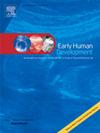内化轨迹在非常早产/非常低出生体重后的成人财富和社会关系中的作用。
IF 2
3区 医学
Q2 OBSTETRICS & GYNECOLOGY
引用次数: 0
摘要
背景:非常早产(VPT)个体;目的:研究从童年到成年早期的内化轨迹是否介导或调节了非常早产/VLBW出生与成年财富和社会关系困难之间的关联。方法:数据来自巴伐利亚纵向研究(252名VPT/VLBW, 228名足月出生),从出生到34岁。父母在四个阶段(6岁、8岁、13岁和26岁)报告了内化症状,并建立了轨迹模型。通径分析通过这些轨迹测试了VPT/VLBW状态对34岁时预后的直接和间接影响。使用方差分析检验适度性。协变量包括性别、出生时的社会经济地位(SES)和神经感觉障碍(NSI)。结果:出现了三种内化轨迹:持续低(70.4%)、下降(15%)和增加(14.6%)。增加的轨迹在VPT/VLBW出生与低财富和更大的社会关系困难之间起中介作用。在对性别、社会经济地位和自伤进行调整后,只有财富的中介效应仍然显著。间接效应约占总效应的15- 18%。出生组(VPT/VLBW vs足月出生)和内化轨迹对成年结局的相互作用不显著。结论:内化症状的增加部分介导了VPT/VLBW出生对成人财富和社会关系的影响。研究结果强调了持续心理健康支持的价值,特别是对那些出生时患有VPT/VLBW的人。本文章由计算机程序翻译,如有差异,请以英文原文为准。
The role of internalising trajectories in adult wealth and social relationships following very preterm birth/very low birth weight
Background
Individuals born very preterm (VPT; <32 weeks) and/or with very low birth weight (VLBW; <1500 g) are at higher risk for internalising problems and adulthood difficulties. However, internalising symptoms fluctuate over time, and it remains unclear how these patterns of change relate to adult outcomes after VPT/VLBW birth.
Objective
To examine whether internalising trajectories from childhood to early adulthood mediate or moderate the association between VPT/VLBW birth and adult wealth and social relationship difficulties.
Methods
Data were drawn from the Bavarian Longitudinal Study (252 VPT/VLBW, 228 term-born), followed from birth to 34 years. Internalising symptoms were parent-reported at four waves (ages 6, 8, 13 and 26 years) and modelled into trajectories. Path analysis tested direct and indirect effects of VPT/VLBW status on outcomes at 34 years via these trajectories. Moderation was tested using analysis of variance. Covariates included sex, socioeconomic status (SES) at birth, and neurosensory impairments (NSI).
Results
Three internalising trajectories emerged: consistently low (70.4 %), decreasing (15 %), and increasing (14.6 %). The increasing trajectory mediated the association between VPT/VLBW birth and both lower wealth and greater social relationship difficulties. After adjusting for sex, SES, and NSI, only the mediation effect on wealth remained significant. Indirect effects accounted for approximately 15–18 % of the total effects. Interactions between birth group (VPT/VLBW vs. term-born) and internalising trajectory on adult outcomes were non-significant.
Conclusions
Increasing internalising symptoms partially mediate the impact of VPT/VLBW birth on adult wealth and social relationships. Findings highlight the value of continuing mental health support, particularly for those born VPT/VLBW.
求助全文
通过发布文献求助,成功后即可免费获取论文全文。
去求助
来源期刊

Early human development
医学-妇产科学
CiteScore
4.40
自引率
4.00%
发文量
100
审稿时长
46 days
期刊介绍:
Established as an authoritative, highly cited voice on early human development, Early Human Development provides a unique opportunity for researchers and clinicians to bridge the communication gap between disciplines. Creating a forum for the productive exchange of ideas concerning early human growth and development, the journal publishes original research and clinical papers with particular emphasis on the continuum between fetal life and the perinatal period; aspects of postnatal growth influenced by early events; and the safeguarding of the quality of human survival.
The first comprehensive and interdisciplinary journal in this area of growing importance, Early Human Development offers pertinent contributions to the following subject areas:
Fetology; perinatology; pediatrics; growth and development; obstetrics; reproduction and fertility; epidemiology; behavioural sciences; nutrition and metabolism; teratology; neurology; brain biology; developmental psychology and screening.
 求助内容:
求助内容: 应助结果提醒方式:
应助结果提醒方式:


